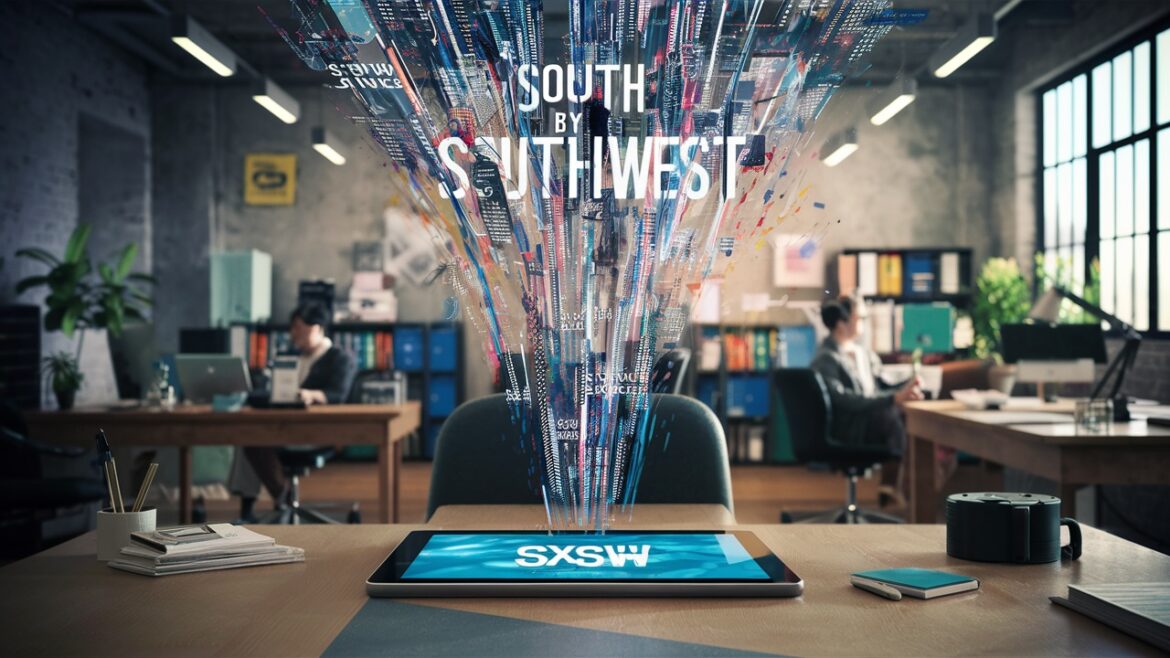Innovation at SXSW: What public media should know

Chad Davis, using Ideogram 1.0
Every March, the world of emerging media turns its attention to Austin, Texas, for South by Southwest (SXSW) Interactive. The interactive conference is part of the larger SXSW multiweek event, which grew in cultural significance on the backs of robust music and film festivals (e.g., New Order keynoted there last year, and Everything Everywhere All at Once premiered there in 2022).
But about 15 years ago, Interactive became the dominant driver of attendance for the festival and thought leadership for the industry. Today, it is known for its focus on the cultural and social impact of emerging technology, digital creativity and innovative thinking; a Chautauqua at a global scale. It acts as a professional hub, featuring a variety of talks, panel discussions and networking events for tech industry professionals, entrepreneurs and digital creatives. And it’s the only conference I’ve found where you can get exposure to cutting edge tech and the philosophical foundations for its ethical use.
I’ve been attending “South-by” since 2011. Watching multiple tech trends cycle through, I’ve come to see this “spring break for nerds” as a mirror on tech and society. The normal ebbs and flows of hype cycles make every year’s conference a little different from the years before (and after).
Here are three takeaways from this year’s conference that I think are relevant to how we think about the future of public media.
AI: ubiquitous and perplexing
The production timing of a conference the size of SXSW doesn’t always sync up perfectly with the zeitgeist. Though ChatGPT brought the generative AI revolution to the masses in December 2022, most of the content for the March 2023 SXSW conference had been locked in the previous October. Consequently, last year we saw around 20 sessions on AI. This year that number quadrupled to more than 80.
And yet, there is a struggle to both say something new and something that won’t be out of date in a week. There also seems to be a pensive uncertainty prevalent as people assess whether the hype around AI is supported by actual economic utility or if this is the bubble ripe to deflate. As a result, the discussions about AI are grappling in real time with the speed of the developments in the field and with their true significance.
What does it mean for public media?
Through experiments at stations, PBS and NPR, the public media ecosystem, writ large, is in a better position than it often is with emerging media. So however it may feel, if you’re staying current with developments in generative AI, you are truly not falling behind.
But research needs to be paired with action if you want to translate innovation into actual change. Are you encouraging your teams to experiment with (non-editorial) AI efficiencies? Have you considered a policy (or at least guidelines) on what is an acceptable use of generative AI? If not, now is the time. Even if the hype cycle takes us into a season of senescence for AI, it won’t stop the cultural changes that are taking root as the use of these tools becomes the norm.
Here are 11 sessions (out of 80) worth sampling to keep you up to speed:
- AI and Humanity’s Co-evolution with OpenAI’s Head of ChatGPT [Video]
- AI and Journalism: The Massive Consequences When Truth is AI
- AI and the Future of Truth [Video]
- AI News That’s Fit to Print
- A.I. Won’t Give You Chills: The Future Runs on Intuition
- Beyond Generative AI: Multimodal Narrative Experiences
- Beyond Code: The Legal and Regulatory Matrix of AI
- Defending Reality vs Gen AI: The War Against Deepfakes
- Designing Successful AI Products and Services
- Unconventional AI: Exploring Orthogonal Strategies
- Visual (R)evolution: How AI is Impacting Creative Industries
The metaverse: playable and growing
Given the dominant focus on AI, the topic of the metaverse could have easily been pushed into the background. But there is clearly still plenty to discuss when it comes to the next generation of the internet, with the number of sessions on the metaverse and extended reality (xR) jumping 50% over last year’s total. This year’s metaverse sessions had more niche subject matter, with session topics focused on design-oriented themes, best practices tied to successful xR location-based experiences, and Apple’s push into “spatial computing” with the Vision Pro.
Running parallel to this was a focus at the conference on the game industry. Video games are increasingly recognized as a dominant force shaping the future of media by blending interactivity, storytelling and technology. The oldest “gamers” are now nearing 60 and have lived a lifetime with increasingly immersive experiences that go beyond traditional media. Today, these experiences allow users to actively participate in and shape narratives, fostering a deeper level of engagement.
What does it mean for public media?
Engagement leads to impact. Games already serve as platforms for social interaction, creative expression and virtual experiences that cause us to rethink media and entertainment. And as AI enhances the interconnectivity of the metaverse, the influence of games and gamer culture will only increase in potency.
Tracking the evolution of next-gen internet remains a crucial aspect of any good public media SWOT analysis. As organizations that successfully mastered traditional media formats, we’ll need to engage in the doubly hard task of adaptation, incorporating more interactive and immersive elements to stay relevant and engaging in a world where audience agency incorporates game mechanics and storyworlds. How are you planning to extend public media’s core values beyond traditional broadcasting and social media distribution? How can your organization embrace “lifelong play” to serve the gamers in your neighborhood?
Here are 11 sessions (out of about 50) worth sampling to reengage with the topics of the metaverse, xR and gaming:
- All About Games. Data, Trends, and What’s Next for 2024
- Bracing for the Coming AI-Powered Metaverse
- Can Video Games Treat Mental Health? The Power of Play
- Immersive Storytelling & Museums: Case Study on JFK Memento
- Read Write Own: Building the Next Era of the Internet
- Stop Blaming Video Games for Society’s Problems
- Storytelling in the Age of Virtual Worlds, Web3 & AI
- Storyworlds, Hour Blue & Amplifying Humanity Ethically with AI [Video]
- Transmedia is Back – But What Comes Next?
- Who is Real? Augmentation vs Authenticity of AI Agents in VR
- XR in the Age Of Vision Pro
The future: visible and trending
You’d think that a focus on the future is just baked into the SXSW experience. And while yes, the word “future” does get bandied about a lot every year, this year there was a heightened focus on how to anticipate and prepare for the future. After a year of the generative AI arms race and the corresponding questions about the actual value of being human, the business world seems to be saying, “How do we make sure that our strategies actually prepare us for the future?”
What does it mean for public media?
In short, public media needs a futurist. Or, if not a futurist, a more concrete, systemic approach to the discipline of strategic foresight across all the major players in our ecosystem. And this isn’t limited to issues stemming from emerging media either. For example, if advances in biotech help Americans start living appreciably longer in the next five years, what does that do for your organization’s strategy around bequests? Or your plans to finally cancel Lawrence Welk?
Here are 11 sessions (of 37) worth sampling to start thinking more broadly about the future:
- 10 Breakthrough Technologies of 2024
- 2024 Emerging Tech Trend Report
- Co-Creating the Near Future with Spatial Computing & AI
- Designing the Future: How Innovators Create What’s Next
- Exploring Emerging Tech: Real vs. Hype
- From the Fireside to the Future: Stories in a Changing World
- Imagine Harder: Prototyping Impossible Futures
- Mind-Machine Merge: 7 Future Trends in a Post-AI World of Work
- The FCC and the Next Frontier Of Connectivity
- The New Dynamics of Trust
- The Real-Time Internet & Other GAI Futures
- Why Your Organization Needs a Futurist in Residence!
A portable SXSW
The value in attending stems from the ideas you generate and contacts you make in real time. But one of the open secrets about SXSW is that anyone can learn from the sessions, as most are recorded and made available online.
I’ve pulled together about 200 of those sessions on the topics of strategic foresight, AI, DEI and accessibility, design, the game industry, the metaverse and xR, and work and career into A Portable SXSW (2024 Edition).
This year, a group of about 15 represented public media in Austin. The recent Public Media Innovators webinar, “Innovation at SXSW: What Public Media Stations Should Know,” offered a diverse set of takeaways from the conference. You can watch it here. PBS NC’s David Huppert, who produced and hosted the webinar, also compiled the panelists’ favorites into SXSW 2024: Top Sessions. You can check it out on the Public Media Innovators’ page. South by Southwest 2025 runs March 7–15. Email me if you’d like more info about budgeting (or justifying the budget) to attend.
Chad Davis is the Chief Innovation Officer at Nebraska Public Media, where he leads Nebraska Public Media Labs, an R&D division focused on emerging media. Chad is also the inaugural Chair of the Public Media Innovators peer learning community at NETA and writes a weekly newsletter about the intersection of public and emerging media. (This commentary was adapted from his newsletter.) To join the PLC, subscribe to the newsletter or talk to Chad about gAI and emerging media, you can email him at cdavis@nebraskapublicmedia.org.






